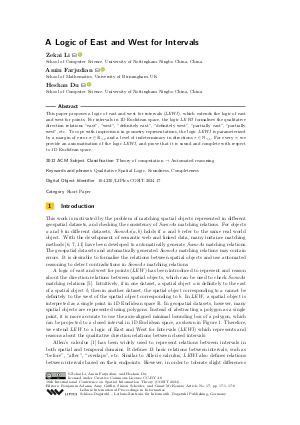A Logic of East and West for Intervals (Short Paper)
Authors
Zekai Li  ,
Amin Farjudian
,
Amin Farjudian  ,
Heshan Du
,
Heshan Du 
-
Part of:
Volume:
16th International Conference on Spatial Information Theory (COSIT 2024)
Part of: Series: Leibniz International Proceedings in Informatics (LIPIcs)
Part of: Conference: Conference on Spatial Information Theory (COSIT) - License:
 Creative Commons Attribution 4.0 International license
Creative Commons Attribution 4.0 International license
- Publication Date: 2024-09-09
File

PDF
LIPIcs.COSIT.2024.17.pdf
- Filesize: 0.76 MB
- 8 pages
Document Identifiers
Subject Classification
ACM Subject Classification
- Theory of computation → Automated reasoning
Keywords
- Qualitative Spatial Logic
- Soundness
- Completeness
Metrics
- Access Statistics
-
Total Accesses (updated on a weekly basis)
0PDF Downloads0Metadata Views
Abstract
This paper proposes a logic of east and west for intervals (LEWI), which extends the logic of east and west for points. For intervals in 1D Euclidean space, the logic LEWI formalises the qualitative direction relations "east", "west", "definitely east", "definitely west", "partially east", "partially west", etc. To cope with imprecision in geometry representations, the logic LEWI is parameterized by a margin of error σ ∈ ℝ_{> 0} and a level of indeterminacy in directions τ ∈ ℕ_{> 1}. For every τ, we provide an axiomatisation of the logic LEWI, and prove that it is sound and complete with respect to 1D Euclidean space.
Cite As Get BibTex
Zekai Li, Amin Farjudian, and Heshan Du. A Logic of East and West for Intervals (Short Paper). In 16th International Conference on Spatial Information Theory (COSIT 2024). Leibniz International Proceedings in Informatics (LIPIcs), Volume 315, pp. 17:1-17:8, Schloss Dagstuhl – Leibniz-Zentrum für Informatik (2024)
https://doi.org/10.4230/LIPIcs.COSIT.2024.17
BibTex
@InProceedings{li_et_al:LIPIcs.COSIT.2024.17,
author = {Li, Zekai and Farjudian, Amin and Du, Heshan},
title = {{A Logic of East and West for Intervals}},
booktitle = {16th International Conference on Spatial Information Theory (COSIT 2024)},
pages = {17:1--17:8},
series = {Leibniz International Proceedings in Informatics (LIPIcs)},
ISBN = {978-3-95977-330-0},
ISSN = {1868-8969},
year = {2024},
volume = {315},
editor = {Adams, Benjamin and Griffin, Amy L. and Scheider, Simon and McKenzie, Grant},
publisher = {Schloss Dagstuhl -- Leibniz-Zentrum f{\"u}r Informatik},
address = {Dagstuhl, Germany},
URL = {https://drops.dagstuhl.de/entities/document/10.4230/LIPIcs.COSIT.2024.17},
URN = {urn:nbn:de:0030-drops-208320},
doi = {10.4230/LIPIcs.COSIT.2024.17},
annote = {Keywords: Qualitative Spatial Logic, Soundness, Completeness}
}
Author Details
References
- James F. Allen. Maintaining Knowledge about Temporal Intervals. Communications of the ACM, 26(11):832-843, 1983. URL: https://doi.org/10.1145/182.358434.
-
Philippe Balbiani, Jean-François Condotta, and Luis Fariñas del Cerro. A Model for Reasoning about Bidimensional Temporal Relations. In Proceedings of the 6th International Conference on Principles of Knowledge Representation and Reasoning (KR), pages 124-130, 1998.

-
Nikolaj S. Bjørner, Clemens Eisenhofer, and Laura Kovács. Satisfiability modulo custom theories in Z3. In Proceedings of the 24th International Conference on Verification, Model Checking, and Abstract Interpretation (VMCAI), volume 13881 of Lecture Notes in Computer Science, pages 91-105. Springer, 2023.

-
Ronald J. Brachman and Hector J. Levesque. Knowledge Representation and Reasoning. Elsevier, 2004.

-
Heshan Du, Natasha Alechina, Amin Farjudian, Brian Logan, Can Zhou, and Anthony G Cohn. A logic of east and west. Journal of Artificial Intelligence Research, 76:527-565, 2023.

-
Jérôme Euzenat and Pavel Shvaiko. Ontology Matching, Second Edition. Springer, 2013.

-
Nikolaos Karalis, Georgios M. Mandilaras, and Manolis Koubarakis. Extending the YAGO2 knowledge graph with precise geospatial knowledge. In Proceedings of the 18th International Semantic Web Conference (ISWC), volume 11779 of Lecture Notes in Computer Science, pages 181-197. Springer, 2019.

-
Robert E. Shostak. Deciding Linear Inequalities by Computing Loop Residues. Journal of the ACM, 28(4):769-779, 1981.

-
Spiros Skiadopoulos and Manolis Koubarakis. Composing cardinal direction relations. Artificial Intelligence, 152(2):143-171, 2004.

-
Spiros Skiadopoulos and Manolis Koubarakis. On the consistency of cardinal direction constraints. Artificial Intelligence, 163(1):91-135, 2005.

-
Nicolas Tempelmeier and Elena Demidova. Linking openstreetmap with knowledge graphs - link discovery for schema-agnostic volunteered geographic information. Future Gener. Comput. Syst., 116:349-364, 2021.

-
Marc B. Vilain and Henry A. Kautz. Constraint Propagation Algorithms for Temporal Reasoning. In Proceedings of the 5th National Conference on Artificial Intelligence (AAAI), pages 377-382, 1986.

